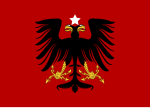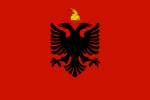Flag of Albania
| Flag of Albania | |
|---|---|
 |
|
| Vexillological symbol : |
|
| Aspect ratio: | 5: 7 |
| Officially accepted: | April 7, 1992 |
The flag of Albania is a red flag with a black, two-headed eagle in the middle. It has had its current form since April 7, 1992. The double-headed eagle is an old symbol that was already used by the Byzantine Empire (see palaeologists ) and the Holy Roman Empire .
history

Origins
The flag is derived from a seal of Skanderbeg , the Albanian national hero who led the Albanians in an uprising against the Ottoman Empire in the 15th century and brought a short period of independence (1443–1478). Skanderbeg's eagle goes back to Byzantine models. And in honor of Skanderbeg, who fought the Turks for 25 years and fought a total of 25 battles against them until his death, the double-headed eagle was given 25 feathers.
The double-headed eagle was handed down to modern times among the Albanians in Italy, the Arbëresh . An eagle can also be found on the grave of a nephew of Skanderbeg in Naples . The flag reappeared in Albanian publications published outside the Ottoman Empire at the end of the 19th century in connection with the emerging national consciousness of Albanians .
In April 1911, Dedë Gjon Luli proclaimed the country's independence in Deçiq near Tuzi when he and his men, the Malesori , were fighting two fronts against Slavs and Turks . This was the first time in 500 years that the flag with the black eagle on a red background had been shown again. On November 28, 1912, the leaders of the Albanian national movement in Vlora proclaimed independence again, which was then recognized in 1913.
Ekrem Bey Vlora (1885–1964) described in his memoirs the hoisting of his flag after the declaration of independence, because "completely incorrect versions were circulated":
“I was promised that they would put it back in a few days, as soon as Ms. Marigo Posio (a tall, advertising, democratic patriot from Korçë) had finished sewing and embroidering the new flag. On November 28th, with that typically Albanian-Oriental carelessness, the main object of the day, "the flag" as a symbol of sovereignty, was forgotten. Most of them had no idea what this flag looked like. No one had ever seen or used them. Nobody owned one in Vlorë. The great founders of the state looked at each other helplessly. Then my friend Hydai Efendi stepped forward and reported that in Ekrem Bey's bedroom an Albanian flag was nailed to a beautiful frame on the bed wall. He asked if it could be taken in spite of the owner's absence. Ismail Bey agreed, and so the flag that Don Aladro Kastriota had given me in Paris went into the hands of Ismail Bey in the neighboring house of the Konak, who handed it to Murat Bey Toptani with the command to hoist it while he was standing by the window. "
Historical flags
At the time of the principality under Prince zu Wied (1914) the eagle had golden beaks and claws. Above him was a white five-pointed star. The German painter Emil Doepler had drafted flags and standards for Albania on February 17, 1914 in Berlin: the national and trade flags as well as three prince standards. When the republic was introduced, the star was removed.
In the Kingdom of 1928 the eagle was changed and given the golden helmet of the Skanderbeg . In 1939 Italy occupied the country and framed the eagle with two bundles of lictors and a banner on which the letters "FERT", the motto of the House of Savoy , which ruled Italy at the time, are written three times .
The communists removed the bundle and helmet and placed a gold-rimmed red star over the eagle .
 ? Provisional Government of Albania (1912 to 1914)
? Provisional Government of Albania (1912 to 1914)
 ? Principality of Albania (1914 to 1920)
? Principality of Albania (1914 to 1920)
 ? Principality of Albania (1920 to 1925) and Republic of Albania (1925 to 1926)
? Principality of Albania (1920 to 1925) and Republic of Albania (1925 to 1926)
 ? Republic of Albania (1926 to 1928)
? Republic of Albania (1926 to 1928)
 ? Kingdom of Albania (1928 to 1939)
? Kingdom of Albania (1928 to 1939)
 ? People's Republic of Albania (1944 to 1946)
? People's Republic of Albania (1944 to 1946)

 ? People's Republic of Albania (1946 to 1991) and Republic of Albania (1991 to 1992), aspect ratio 5: 7
? People's Republic of Albania (1946 to 1991) and Republic of Albania (1991 to 1992), aspect ratio 5: 7
Other flags of Albania
The service and war flags at sea are based on the Soviet naval flag . The various branches of service were given their own flags on January 1, 2008.
 ? Service flag at sea
? Service flag at sea
Community flags
In 2004 the coat of arms of Tirana was used on a flag with a light blue background. It is unclear whether it is still in use today.
Party flags
Minorities
The Greek minority in southern Albania should use a flag with a blue cross on a white background and a blue border. The center of the cross is covered with the black Albanian double-headed eagle.
Flag of the Arbëresh
Use in neighboring countries
The flag of Albania is used everywhere, including outside Albania, by ethnic Albanians as a national symbol. Although it has no official status there, it can be seen everywhere where Albanians live , especially in Kosovo and North Macedonia .
Web links
Individual evidence
- ↑ a b Ekrem Bey Vlora: Memoirs (1912 to 1925) . In: Mathias Bernath (Ed.): Southeast European works . tape II . R. Oldenbourg Verlag, Munich 1973, ISBN 3-486-47571-1 .
- ↑ Flags and badges of the branches of service of the Albanian armed forces (with illustrations; PDF; 2.8 MB).
- ↑ Flags of the World - Tirana (Town, Albania) ( Memento from April 9, 2014 in the Internet Archive )
- ↑ Photo Lulzim Basha. In: Flickr. June 19, 2015, accessed December 1, 2015 .
- ^ Partia Socialiste e Shqipërisë. Photo. In: Facebook. June 9, 2013, accessed December 1, 2015 .
-
^ Flags of the World ( Memento December 30, 2013 in the Internet Archive ) - with reference to John Edwards;
Ralph GC Bartlett: Flags of Aspirant Peoples from the Flag Society of Australia, 1994. - ↑ Cyrill Stieger: Nationalism in the Balkans: The Albanians are moving closer together. In: Neue Zürcher Zeitung . March 23, 2013, accessed on March 26, 2013 : “The Albanians, as is customary everywhere in the Balkans, mostly define the nation as ethnic and not civic. The flag of Albania, the black double-headed eagle on a red background, flies wherever Albanians live. The identification with the nation overlays that with the state. "

















